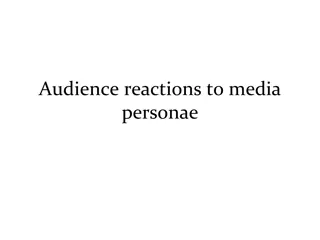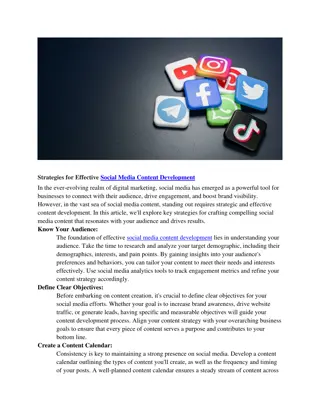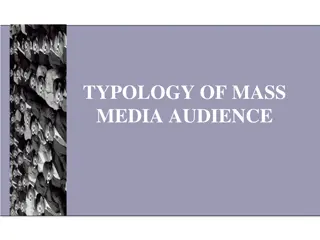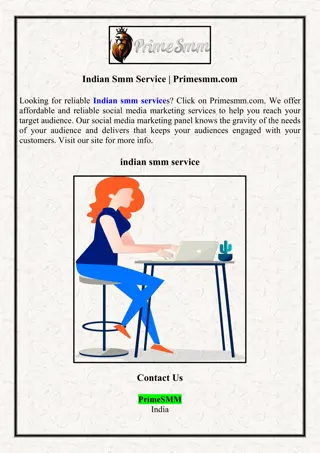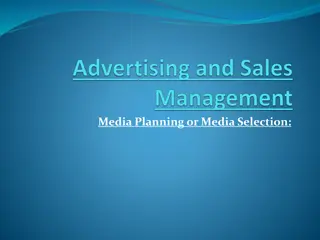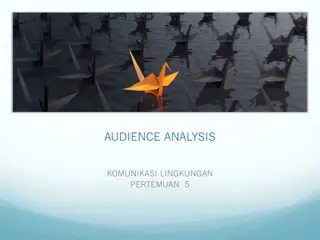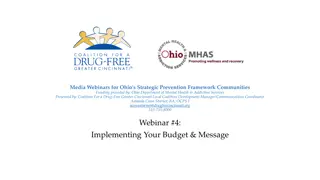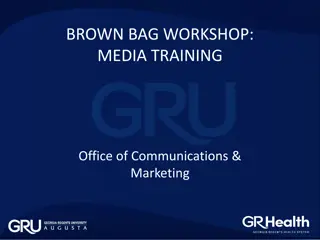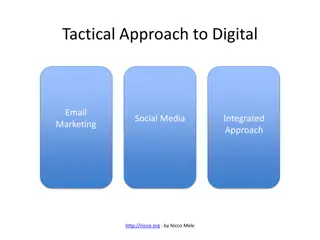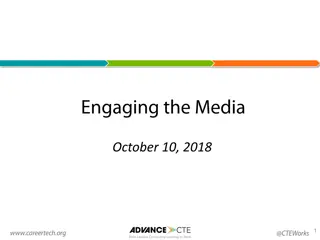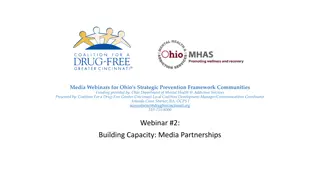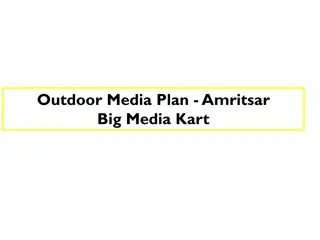Effective Media Strategy for Target Audience Reach
Understanding the audience, cost considerations, and media consumption patterns are crucial in developing an effective media strategy. It involves evaluating reach, frequency, CPM, CPP, GI, GRPs, and utilizing emerging media channels for maximum impact and allocation of media weight. The goal is to optimize message delivery, audience exposure, and engagement within budget constraints.
Download Presentation

Please find below an Image/Link to download the presentation.
The content on the website is provided AS IS for your information and personal use only. It may not be sold, licensed, or shared on other websites without obtaining consent from the author. Download presentation by click this link. If you encounter any issues during the download, it is possible that the publisher has removed the file from their server.
E N D
Presentation Transcript
Who am I trying to reach? How many can I afford to reach? How often do people need to encounter my message? In which vehicles should I pursue message space? When should I communicate (day, week, month, year)? What markets and regions should receive extra emphasis and which ones can be ignored? How can I take advantage of emerging media?
Selection based on audience and costs What does your target consume? How much can you afford? Audience measures Gross impressions & Gross rating points (GRPs) Reach & Frequency - How many and how often Cost per thousand (CPM) and Cost per point (CPP)
In media, primarily concerned with accumulation of audience Each audience member exposed to the message is considered an impression Summed to equal gross impressions Audience size = gross impressions for single show For multiple programs, add audience sizes together for total gross impressions (GI)
Same logic applies to rating points Rating for individual programs are added together to calculate the total rating points accumulated across a schedule Gross Rating Points = GRPs Ex. Rating for Program 1 + Rating for Program 2 + Rating for Program 3 Gross Rating Points
Gross impressions (GI) Total number of exposures - duplication counts Exposures (Ad 1) + Exposures (Ad 2) + Exposures (Ad 3) 2 ads in 60 minutes each generate 6.5 Million HH impressions + 1 ad in NCIS: Los Angeles generates 8.5 Million HH Impressions Total impressions = 21.5 Million or 21,500,000 Gis To Convert to Ratings, must know the total audience size, in this case, Total TV HHs (119.6 Million TV HH in US) Gross rating points (GRPs) GRPs = GI / Total population (x 100 to convert to %) Can be over 100, and often is 5.4 rating + 5.4 rating + 7.1 rating = 17.9 GRPs GRP s are easier way of allocating media weight
Program. Rating. Aud. Size Units GRPs GI NCIS: LA 7.1 8.5 10 71.1 85.0 Big Bang 6.0 7.2 8 48.2 57.6 60 Minutes 5.4 6.5 14 76.1 91.0 Olympics 3.7 4.4 9 33.1 39.6 Total 41 228.4 273.2
Your schedule generates 273.2 mm HH GI yet there are only 119.6mm TV HH How is this possible? Your schedule generates 228.4 GRPs, with each GRP equal to 1% of the audience How can you have more than 100%
GRPs and GI allow for the duplication of impressions Someone might see more than one ad in your schedule Ex. NCIS and 60 Minutes Ex. multiple episodes of NCIS Ex. multiple ads in a single show
Percent of audience exposed at least once Overall - Household reach Target - Reach of specific audience Average Number of times exposed Average frequency x Reach = GRP
Viewers Average Number GRPs = Counted X of Times Once They View GRPs = Reach X Frequency Reach is net unduplicated audience Frequency is average number of exposures
Back to our 41 unit schedule of ads GRPs = 228.4 Reach = 75.0 (estimated) Frequency = 3.04 Numbers comes from reach curves that contain reach estimates for various media vehicles and GRP levels Frequency is then calculated from reach
Percent of Audience 30% 25% 20% 15% Percent of Audience 10% 5% 0% 0 1 2 3 4 5 6 7 8 9 10 Frequency of exposures
Combines reach and frequency Threshold: minimum effective frequency Usually 3+ Ideal exposure frequency Varies by message complexity Varies by strategic goals
Cost in relation to target delivered Cost per thousand (CPM) Cost per rating point (CPP) CPP used to compare efficiency of advertising media to one another
Program Rating Aud. Size # Ads GRPs GI Cost / unit Total Cost CPM CPP NCIS 7.1 8.5 10 71.1 85.0 400,000 4,000,000 $47.06 $56,282 Big Bang Theory 6.0 7.2 8 48.2 57.6 350,000 2,800,000 $48.61 $58,139 60 Minutes 5.4 6.5 14 76.1 91.0 275,000 3,850,000 $42.31 $50,600 Olympics 3.7 4.4 9 33.1 39.6 200,000 1,800,000 $45.45 $54,364 Total/Overall 41 228.4 273.2 12,450,000 $45.57 $54,503
CPM = Cost per thousand impressions CPM = Cost of ads / Total GIs in (000) Ex. CPM for NCIS CPM = $400,000 / 8,500(000) = $47.06 Ex. CPM for 41 unit schedule CPM = $12,450,000 / 273,200(000) = $45.57
CPP = Cost per rating point CPP = Cost of ads / Total GRPs Ex. CPP for NCIS CPP = $400,000 / 7.1 = $56,282 Ex. CPP for 41 unit schedule CPP = $12,450,000 / 228.4 = $54,503
Choose your mediums Fill out the Media Buying Spreadsheet Figure out how much you want to spend across year Fill out the Media Buying Flow Chart Write up your media plan, which includes: 1. Reach and frequency goals 2. Duration, Timing, Regional Emphasis 3. Scheduling strategy (spreadsheet/flow chart explanation) 4. Rationale of strategy 1. 2. 3. 4. 5.
Impact Media Digital Flat-Rate Digital CPM Traditional Media
What you need: # Units per media buy Cost per unit (found in manual) What the spreadsheet will calculate: Overall cost ($ allocation)
What you need: # Units per media buy (1 unit = 1 month, 1 ad) Cost per unit (found in manual) What the spreadsheet will calculate: Overall cost ($ allocation)
What you need: # units per media buy (1 unit = 1 month, 1 ad) Cost per mille (price per 1,000 impressions) (found in manual) # impressions desired What the spreadsheet will calculate: $ allocation
Traditional media is calculated from the remainder of your budget Spot vs. National Media What you need: Cost per point (found in manual) % you want to allocate What the spreadsheet will calculate: $ Allocation GRPs (Gross Rating Points you will use this in the flow chart)
Say I wanted to buy the following things: Academy Award Ad Spot 1 month of billboards in the NYC market (January) Five Promoted Tweets A Buzzfeed Article An Instagram Ad with 10,000,000 impressions How much would this cost?
Say I wanted to buy the following things: Academy Award Ad Spot 1 month of billboards in the NYC market (January) Five Promoted Tweets A Buzzfeed Article An Instagram Ad with 10,000,000 impressions How much would this cost? Answer needed
4 Spreadsheets Impact Digital Traditional Summary Chart
Impact media used to launch campaigns or promotions Some media (e.g., radio, SEM) make sense to buy continuously, Others (e.g., prime time) usually bought in pulses to manage costs Digital and traditional media strategy doesn t need to be the same
1. Choose your mediums 2. Fill out the Media Buying Spreadsheet 3. Figure out how much to spend across the year 4. Fill out the Media Buying Flow Chart 5. Write up your media plan, which includes: 1. Reach and frequency goals 2. Duration, Timing, Regional Emphasis 3. Scheduling strategy (explanation supporting the spreadsheet/flow chart) 4. Rationale of media selection strategy
Reach: How large is your audience? National audience or a specific region? Target a specific demographic group? Must decide whether reaching all is a priority Frequency: How often is audience seeing ad? How often should your audience see it? Sometimes we need more frequency to be noticed The broader your audience, the harder it is to reach them frequently.
Duration: When to when? Timing: When are your pulses? Media aperture: What daypart will you focus on? Example: When would you advertise for coffee? Region: Are you emphasizing a region Part of the country, metro area, county size This should be reflected in your spreadsheets.
What is your overall strategy? (Pulse, flight, continuous) Do you have different strategies for different media? Describe the media plan for each media category (impact, digital-flat, digital-CPM, and traditional) You can describe digital together Be specific about which magazines, websites, radio formats, tv shows, and cable networks you want to use. Editorial compatibility Why does this medium s content make sense with your ad? Rationale for these choices How do you know these choices put the ads in front of the right people?
GI: Gross Impressions, total # of impressions GI = Ad1 Views + Ad2 Views + Ad3 Views GRP: Gross Rating Points GRP = GI / total population GRP = viewers (reach) x # of times seen (frequency) GRP = Rating of ad 1 + rating of ad 2 + rating of ad 3 I have an advertisement that will be aired twice on a show with a rating of 2.5. What is the GRP? 5.0
I have an ad that will be aired four times. In the first two instances, it will be viewed 5,000,000 times each. Then, it will air in a more popular outlet, where it will be viewed 8,000,000 times. We will finally put the ad online, where it will be seen an additional 3,000,000 times. What are the Gross Impressions of this advertisement? 21,000,0000
CPM: Cost per thousand CPM = cost of ad / total GI (in 1,000 s) CPP: Cost per point CPP = cost of ad / total GRP I have an advertisement that cost $100,000 dollars, that will be viewed 20,000,000 times. What is the CPM? 100,000 / 20,000(000) = $5.00
CPP: Cost per point CPP = cost of ad / total GRP GRP: Gross Rating Points I am placing an advertisement in a magazine that generates a 1.3 rating at a CPP of $50,000. How much is the advertisement? = $65,000




